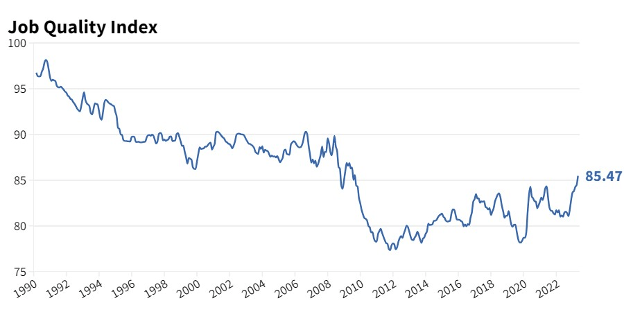WASHINGTON — The Coalition for a Prosperous America (CPA) today announced that the U.S. Private Sector Job Quality Index (JQI) for May was 85.47, up 0.83% from April. The JQI reached its highest level in over a decade and has increased the last seven consecutive months after accounting for revisions to recent months. While job growth is slowing, there has been strong growth of high-quality relative to low-quality jobs in the economy.
The average weekly wage for production and nonsupervisory workers in May was $971.25, up 0.2% from April. Wage growth over the last twelve months was 3.9% for production and non-supervisory workers, slightly below the 4.0% rate of annual consumer price inflation for May.
Hiring in goods-producing industries was strong and accounted for 19% of private-sector hiring, up from 9% in the previous month. The construction industry added 23,000. Construction of both manufacturing facilities and multifamily housing is booming, and the industry continues to hire at a strong pace. Furthermore, the construction boom and investment in domestic manufacturing will lead to future employment in the manufacturing industry. The manufacturing industry added 7,000 jobs in June.
Hiring remains strong in health care and social assistance. But most of the jobs added in the sector were low-quality, with only 13,750 high-quality jobs out of a total of 65,100 jobs added in the sector. Education added 8,700 jobs, of which three-quarters were high-quality jobs.
The Bureau of Labor Statistics (BLS) reported overall job gains of 209,000 in June as the unemployment rate fell by 0.1 percentage points to 3.6%. Job gains were slightly below the expectations of economists and headline job growth is slowing.
The Job Quality Index measures job quality for U.S. production and non-supervisory workers by comparing workers’ weekly wages to the mean weekly wage for all non-supervisory workers. Those jobs above the mean are classified as high-quality and those below the mean are low-quality. The index is calculated by dividing the number of high-quality jobs by low-quality jobs. An index of 100 means the number of high-quality production and nonsupervisory jobs is equal to the number of low-quality jobs. An index below 100 means that the economy includes more low-quality than high-quality jobs.
Over the past three decades, the JQI declined because the U.S. economy created more low-quality jobs than it has high-quality jobs. As shown in Figure 1, the JQI is down 11.7% from 1990 illustrating the disproportionate growth in low-wage, low-hour jobs.
Figure 1. Job Quality Index 1990-2023














